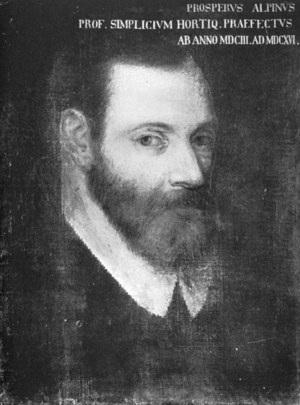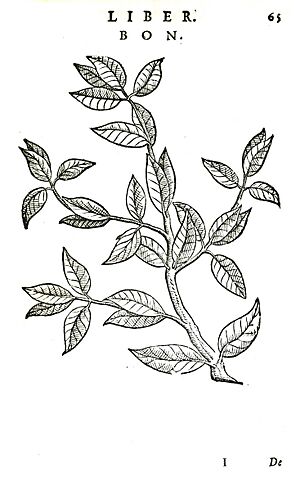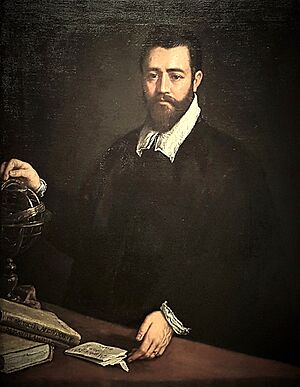Prospero Alpini facts for kids
Quick facts for kids
Prospero Alpini
|
|
|---|---|

Prospero Alpini (1553–1617)
|
|
| Born | 23 November 1553 Marostica, Republic of Venice
|
| Died | 6 February 1617 (aged 63) |
| Nationality | Venetian |
| Alma mater | Padua University |
| Known for | Study of date palms |
| Scientific career | |
| Fields | Botany, Medicine |
| Institutions | Venice, Genoa, Padua |
| Author abbrev. (botany) | Alpino |
Prospero Alpini (born November 23, 1553 – died February 6, 1617) was a Venetian doctor and expert in plants (a botanist). He traveled to Egypt and later became the head of the botanical garden in Padua.
Alpini wrote several important books about plants. These books described many exotic plants that were useful for medicine or for making money. His descriptions of coffee and banana plants are some of the oldest known in Europe. A group of plants in the ginger family, called Alpinia, was named after him by the famous scientist Carolus Linnaeus.
Contents
Prospero Alpini's Life
Prospero Alpini was born in Marostica, a town near Vicenza. His father, Francesco, was also a doctor. When he was young, Alpini served in the army for a short time. But in 1574, he decided to study medicine at Padua University.
After finishing his medical degree in 1578, he became a doctor in a small town called Campo San Pietro. However, he was very interested in plants. To learn more about plants from other countries, he traveled to Egypt in 1580. He went there as a doctor for George Emo, who was the Venetian consul (a government official) in Cairo.
Discoveries in Egypt
Alpini spent three years in Egypt. While there, he learned a lot about how date palms grow. He noticed something very important about how date palms reproduce. He saw that female date trees only produce fruit if they are near male trees. Or, if pollen from the male flowers is sprinkled onto the female flowers.
This observation was a big step in understanding how plants reproduce. It later became a key idea for Linnaeus when he created his system for classifying plants.
Return to Italy
After his time in Egypt, Alpini worked in Genoa as a doctor for Andrea Doria. In 1593, he became a professor of botany at Padua University. In 1603, he was put in charge of the botanical garden in Padua.
Because he knew so much about medicinal plants, many other doctors asked for his advice. Towards the end of his life, he had some health problems, including arthritis. He passed away on February 6, 1617. His son, Alpino Alpini, took over his position as a botany professor.
His Important Books
Alpini's most famous book about plants is De Plantis Aegypti liber (meaning "Book of Egyptian Plants"), published in 1592. This book introduced many new plant species to European scientists. These included plants like Abrus, Abelmoschus, Lablab, and Melochia. These plants usually grow in tropical areas and were grown in Egypt using special watering systems. He also described the baobab tree.
Other botanists quickly started using the new plant names Alpini introduced. These included famous scientists like Carolus Clusius and Johann Bauhin.
Prospero Alpini's book De Plantis Exoticis was published in 1629, after he died. It added more information to his earlier work on Egyptian plants. His book De Plantis Aegypti liber is known for having the first description of the coffee plant published in Europe. Even though another traveler, Leonhard Rauwolf, had tasted coffee earlier, Alpini's detailed description was very important.
He also wrote De balsamo dialogus (1581, 1592), which was one of the first books to focus on just one group of plants. Alpini also wrote about predicting how sick people would recover or if they would die in his book De praesagienda vita et morti aegrotanti (1601). This work made some people see him as a founder of modern medical diagnosis.
The plant group Alpinia, which is part of the ginger family, was named after him by Carl Linnaeus.
List of His Works
- De balsamo dialogus, 1581, 1592.
- De medicina Aegyptiorum, 1591.
- De plantis Aegypti, Venice, 1592.
- De praesagienda vita et morte aegrotantium, 1601.
- De medicina methodica, 1611.
- De Plantis Exoticis, 1629.
- Rerum Aegyptiarum libri IV, 1735.




